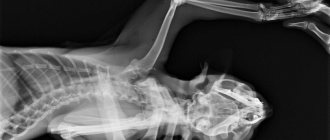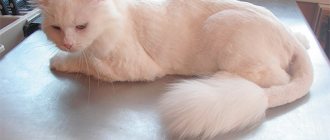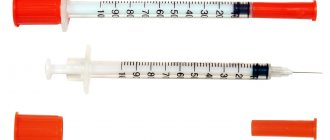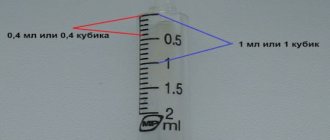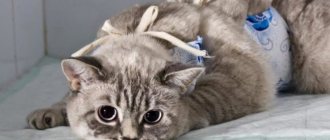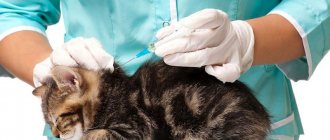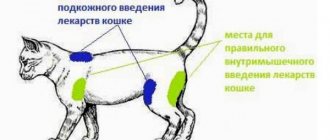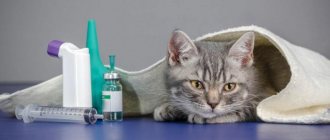The cat is one of the most prolific pets. It is virtually impossible to keep track of someone who lives outside the home. Too frequent births worsen the condition of the pet’s body, and placement of offspring is one of the most difficult issues in keeping a cat.
Almost every cat owner has encountered a situation where she became pregnant, but the kittens are not needed for one reason or another, or the cat’s health may suffer greatly from pregnancy and childbirth. And if there is no possibility of procreation, the question arises of what to do with pregnancy?
Spontaneous abortion in cats
Spontaneous abortion (miscarriage) is an interruption of pregnancy, as a result of which the fetus dies.
Experts identify several reasons that can trigger a miscarriage:
- primary - characterized by genetic problems and infections;
- secondary - formed as a result of the influence of the external environment or pathologies of the placenta.
Timely assistance will keep the cat healthy and prevent the development of pathology in the future.
Spontaneous termination of pregnancy often causes a big blow to the cat’s body. Only in some cases, the fruits can be absorbed in the early stages without causing pain to the pet.
Dangerous consequences of miscarriage:
- If the interruption occurred late. At this time, the fruits are already almost formed, so it will be more difficult for the cat to cope with the release of dead cubs. In some cases, rupture of the reproductive organs and birth canal may occur.
- The remains of the fetus remain in the uterus. If the embryo is not removed in time, it will begin to decompose, thereby poisoning the cat’s body.
- The animal may develop chronic inflammation of the reproductive organs.
- Development of infertility or negative impact on the course of subsequent pregnancies.
Causes and development of abortion in cats
How to give an injection to a cat at the withers: intramuscularly and at home
The main causes of abortion are chronic infections that enter the cat's body before or after mating. However, in addition to diseases, other factors can lead to termination of pregnancy.
Stress factors
Stress for a cat, especially in the later stages, can negatively affect the development of the fetus. Psychological problems can arise against the background of:
- fright;
- moving;
- negative interactions with other animals;
- loss of owner or loneliness;
- long fasting.
Based on the above reasons, it is necessary to monitor the animal’s condition and provide peace of mind to the pregnant cat.
Bacterial infections
Miscarriage is caused by both viral and bacterial infections. The most dangerous infections are:
- leukemia;
- coli;
- herpes;
- panleukopenia (distemper);
- calcivirosis;
- hemobartonellosis.
Such diseases almost always spoil the course of pregnancy and also affect the condition of the pet
Non-infectious causes of miscarriage
Feline abortion can occur due to non-infectious conditions:
- Incorrect position of the fetus in the uterus, post-term pregnancy or fetal deformation.
- Damage to the pelvis, sexual inability of the cat to give birth, too soft birth canal.
- Underdeveloped genitals, abnormal position of the uterus.
- Cyst formation, uterine prolapse.
- Incorrect formation of hormones.
- Pathological conditions of the placenta.
- Use of certain medications.
- Abdominal injuries.
Pathologies of embryonic development
Possible causes of abortion in cats also include pathologies of embryonic development. This may be an excessive or slow rate of fetal development. In some cases, embryos are positioned incorrectly in the uterus, which can lead to further rejection.
For reference: proper development of the fetus is hampered by chromosomal abnormalities that kill the embryo.
A visit to the veterinarian is mandatory
At first glance, it may seem that it is easy to carry out a medical abortion in a cat on your own - you just need to give a pill or inject a drug. But the interruption process can occur with complications. In addition, you need to consult with a specialist which drugs are best to give in a situational situation, namely in your case. Therefore, a visit to the veterinarian is mandatory, at least in the form of a consultation. If you have a miscarriage, it is advisable for a doctor to be nearby and be able to help in a dangerous situation if you do not have the necessary skills yourself.
The following drugs are most effective for abortion in cats:
:
- Estradiol cypionate – from the group of estrogens;
- Fluprostenol, Cloprostenol - from the group of prostaglandins.
Be sure to create the necessary living conditions for the cat after an abortion to avoid side effects and any other complications. Your pet will need rest - give up active games. The cat should get enough sleep and feel comfortable. Do not provoke aggression in your cat. It is also necessary to choose a balanced food, especially if you have sterilized your pet.
Protect your cat from possible drafts and dampness. Coolness can trigger the development of inflammation. It is advisable to protect the cat from the attention of other pets, especially dogs. Regularly monitor your cat’s behavior and health; if there is a sharp deterioration in health, take the cat to the veterinarian.
In veterinary medicine, there are various ways to prevent unwanted pregnancy in a cat. There may be several reasons to resort to such measures: 1. The owner’s desire 2. Testimony from the veterinarian.
Termination of pregnancy in cats
- This is quite a lot of stress for her body. If you do not want offspring from a cat, it is better to take care of this in advance - sterilize or use hormonal drugs for a while, for example, Covinan.
Abortion drugs can have serious side effects and you must be 100% sure that your cat has had intercourse with a male cat and can become pregnant or has already conceived. Pregnancy can be confirmed by a veterinarian approximately 20-22 days after conception. The presence of fetuses in the cat's womb can be diagnosed by abdominal ultrasound or palpation.
If medication is given unnecessarily, it can lead to serious illness.
In veterinary medicine, there are three types of drugs for terminating unwanted pregnancy in cats: estrogens
,
prostaglandins
and
glucocorticoids
.
Estrogens
are drugs that act on a fertilized egg and prevent it from attaching to the uterus. If you give this drug immediately after sexual intercourse with a cat, when pregnancy has not even been confirmed, then in 98% of cases, pregnancy will not occur. But your cat is subject to various side effects after taking estrogen. These include: 1. Suppression of bone marrow function. This condition results in severe anemia when the levels of white blood cells and platelets drop sharply. This may occur two weeks to two months after administration of the drug and is usually an irreversible condition that is ultimately fatal.2. Pyometra is an infection in the uterus of a cat. Typically, this infection is difficult to treat with antibiotics and often requires removal of the ovaries.3. Infertility.
Most commonly used estrogens: Estradiol cypionate Diethylstilbestrol
Prostaglandins
The most common prostaglandins: Fluprostenol, Cloprostenol, Alpha-prostol
Glucocorticoids
The appearance of a cat in the house brings with it not only joy, games and comfort. Sometimes pets make owners nervous. We are talking about unplanned mating and unwanted pregnancy of cats. Then many owners think about interrupting it. This is a dangerous procedure, and veterinarians are sure that it is better to let the cat bear offspring and give birth to them. What do you need to know about abortion in cats? How do they threaten the health of the animal?
How to recognize a miscarriage
Recognizing a miscarriage is not always as easy as it seems at first glance. Indirect symptoms include:
- absence of signs of pregnancy in the first stages after mating;
- in the later stages before a miscarriage, the stomach takes on an asymmetrical shape;
- the pet experiences vomiting and diarrhea;
- sudden loss of body weight and appetite;
- lethargy and fatigue;
- the cat’s aggressiveness when the owner tries to touch the stomach;
- elevated body temperature.
Cat pregnancy by week: calendar
Before the actual expulsion of the fetus from the uterus, the pet begins to experience discharge from the genital tract with various impurities. Owners notice a sharp and unpleasant odor from the cat.
Additional Information! If a miscarriage has already occurred, the pet can eat the remains of the placenta or fetus, or leave it in a visible place and not touch it.
First signs of pregnancy
How do you know if your cat is pregnant? Despite the fact that it is almost impossible to calculate the exact date of conception, there are signs by which one can judge that pregnancy has begun.
The cat's pregnancy calendar is divided into several stages.
- In the first 3 weeks, she does not experience any external changes.
- Usually they begin to be noticed in the third week - the nipples become bright pink and slightly enlarged. Due to the hormonal changes that occur at this stage, as well as the stretching of the uterus, toxicosis is observed in the cat, especially in the morning. It usually ends in 4–5 days.
- From this time on, the animal’s appetite improves, weight gain appears, and the tummy takes on a rounded shape. The cat's taste sensations also change.
- After 6 weeks, the nipples fill with milk, making their enlargement even more noticeable. At this stage, an experienced veterinarian can already feel the embryos.
- In the period from 7 to 9 weeks, the belly becomes larger; by placing your palm on it, you can even feel the kittens moving. The cat sleeps most of the time. Due to increased intra-abdominal pressure, he goes to the toilet more often than usual.
- In the last week, appetite decreases, and the stomach moves closer to the ribs and seems to sag. Mucous discharge in a pregnant cat that appears at this time indicates that the day of delivery is approaching.
Laboratory tests for abortion
How to help a cat in the heat: examples of what you can do
An abortion for a cat is often performed within the walls of a hospital, so before and after it is carried out, it is necessary to monitor the condition of the animal.
The following types of studies are prescribed:
- Ultrasound;
- blood and urine tests;
- checking for infectious diseases;
- X-ray;
- genital smear;
- hormone research.
A study of the released fetuses is also carried out to establish the exact cause of the pathology.
Treatment of an aborted cat
After a miscarriage or abortion, the cat needs special care. At first, the cat is kept within the walls of the hospital. Since an aborted fetus can cause infection in the pet, the cat is monitored and tested.
In case of infectious infection, the animal is isolated for several weeks until the problem is resolved.
Outpatient treatment involves the use of medications, in particular antibiotics and vitamins
Nutrition for a pregnant cat
A balanced diet is one of the most important conditions for bearing healthy offspring. When feeding a cat dry food, it is transferred to a special diet intended for pregnant women. If an animal is fed a natural diet, it should be complete and varied.
Products are included in the menu depending on the breed, age of the cat and its size. The stage of pregnancy also matters. For example, in the first half the cat’s body needs calcium, in the second half it especially requires protein.
The daily diet must include meat (beef, chicken, turkey). During this period, you can give your cat rice or buckwheat porridge, low-fat cottage cheese, kefir, pureed zucchini, carrots, and cabbage.
The diet changes according to the weeks of pregnancy:
- At the very beginning, the cat needs 10% more food than usual. At the same time, it is given a little at a time, but the frequency of feeding increases to 4–5 per day (especially starting from the fifth week, when the kittens begin to grow). The main thing is not to overfeed the animal.
- Approximately 2 weeks before birth, the amount of food is reduced. Otherwise, kittens that are too large can cause complications during childbirth.
- In the second half of pregnancy, it is recommended to add scalded and finely chopped nettle leaves to cat food.
- In recent days, you can give a decoction of raspberry leaves, which can ease the birth process.
How to terminate a cat's pregnancy
To answer the question of whether it is possible to terminate a cat’s pregnancy, it is necessary to understand the types of abortion.
There are three types of termination of pregnancy:
- spontaneous;
- surgical;
- medicinal.
Some owners are interested in how to abort a cat at home, because they do not want to take their pet to the hospital. There are pills and injections that the owner can give and this will cause rejection of the fetus. However, this method is not safe. A person without certain knowledge will not be able to choose the right remedy and prescribe the dosage. Thus, you can cause harm to your pet, even death.
Important! Any intervention must be carried out under the supervision of a veterinarian. In this case, the risks of complications for the pet’s health are reduced.
In some cases, surgery is undesirable for the cat, so medications are prescribed. This method is more gentle than surgery.
To understand how to cause a cat to miscarry, you need to study the main groups of medications:
- Based on estrogen. This group is the most dangerous, as it causes many side effects. They are used to terminate pregnancy for a period of 2-7 weeks. Taking medications can cause your cat to develop uterine bleeding or pyometra.
- Prostaglandins. They are also used to terminate early pregnancies. The substances act in such a way that the level of progesterone in the cat’s body decreases and a miscarriage occurs.
- In later stages, glucocorticoids are used. Such drugs are considered the most dangerous, as they get rid of almost fully formed kittens. Side effects: infertility, pyometra, thirst, frequent urination.
Humane methods of population control
Most veterinarians are confident that sterilizing a cat is a more gentle way to avoid the birth of offspring than abortion.
Sterilization of females and castration of males is achieved by surgical removal of their reproductive organs. The operation is performed under anesthesia and is not associated with serious complications. It increases the cat's life expectancy, eliminates aggressiveness, nervousness, and prevents the development of gynecological diseases.
An alternative to sterilization is hormonal contraception. For example, the use of prolygestone-based drugs inhibits the maturation of ovarian follicles. After the administration of this drug, cats do not develop estrus for 5 months.
Especially for – Ira Romaniy
Types of procedure
Having dealt with the question of whether it is possible to abort a cat, it is necessary to study the types of procedures.
Hormonal methods of abortion
Hormonal methods are based on the use of medications. How to miscarry a cat depending on the period of pregnancy:
- Estrogens are used to reject fetuses immediately after mating. This hormone can prevent pregnancy by preventing the egg from penetrating the walls of the uterus.
- In the middle of the period, prostaglandins are used. As a result of the action of the drug, underdeveloped dead fetuses emerge from the cat.
- In later stages, only glucocorticoids are used. With their help, premature birth is caused. It should be remembered that such births can be very dangerous for the pet.
Experts recommend terminating a pregnancy midterm. This way you can avoid serious consequences for your cat's health.
Non-hormonal methods of abortion in cats
Owners often wonder whether cats undergo abortion using non-hormonal methods, since they do not want to give their pet medications.
The main method is sterilization. The doctor surgically removes the uterus with embryos and ovaries. This method is chosen by owners who do not want to raise cubs.
The longer the period, the more difficult the rehabilitation process will be.
Attention! If the owners do not want to receive offspring from their pet, veterinarians recommend sterilization without waiting for pregnancy to occur.
When answering the question of how to terminate a cat’s pregnancy using folk remedies, you must remember that plants have a negative effect on the pet’s liver and kidneys. However, such tinctures are considered relatively harmless compared to medications and surgeries. The following types of herbs are used: mint, angelica, parsley, angelica.
What is the essence of sterilization?
The sterilization procedure consists of surgically removing the ovaries from a female animal, while preserving the uterus and other reproductive organs. There is a similar operation performed on cats. It's called castration. In this case, the cats' testes are removed. If a similar operation is performed on cats, the uterus is also removed.
The spaying procedure involves removing the cat's ovaries.
Removal of the uterus is practiced to prevent the cat from contracting various diseases. These can be inflammations of various natures, as well as cancer. From a physiological point of view, to interrupt the reproductive function of an animal, it is enough to remove only the ovary, and the uterus can remain intact.
After this operation, your cat will gradually stop producing estrogen over the course of a month. As a result, the hormonal levels will decrease and she will become calm. In this way, you can quickly rid the animal of unnecessary aggressiveness both towards other members of the cat family and towards people.
Removal of the uterus is practiced to prevent the cat from contracting various diseases.
However, there are factors that interfere with sterilization:
- weakened condition of the animal as a result of prolonged starvation;
- presence of diseases;
- state of pregnancy.
If in the first two cases you have to resort to replacement therapy with hormonal drugs, such as Contrasex, then in the case of pregnancy, the decision about possible sterilization will be made by a veterinarian. The fact is that, despite its relative simplicity, such an operation can have a fairly serious impact on the animal’s body. Any type of operation is especially dangerous when the cat is pregnant, because this can lead to both her death and the death of the kittens.
The optimal age for sterilizing a cat is considered to be 7-8 months.
The optimal age for sterilizing a cat is considered to be 7-8 months. It is undesirable to carry it out earlier, since the animal’s body has not yet formed at this time, and therefore there is a high risk of complications. At the same time, there is also no need to delay the operation, since the older the animal, the worse it will tolerate it.
Before surgery, animals over 10 years of age are examined. For example, they donate blood for analysis, have their heart function checked and consult with a cardiologist. This allows the animal to undergo surgery without complications.
Before surgery, animals over 10 years of age are examined
Possible complications and risks
Abortion is a complex process that almost always causes complications. Among them:
- anemia;
- pyometra;
- infertility.
Termination of pregnancy is a difficult emotional and psychological event. In most cases, the instinct of motherhood in cats is easily suppressed after an abortion, since they lose the ability to give birth.
To prevent serious consequences, it is necessary to sterilize the pet in time if the owners do not want to raise kittens. If babies are desired in the family, then it is important to provide the cat with proper care.

